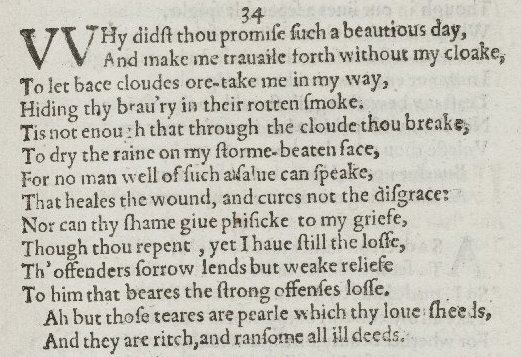Why didst thou promise such a beauteous day,And make me travel forth without my cloak,To let base clouds o’ertake me in my way,Hiding thy bravery in their rotten smoke?’Tis not enough that through the cloud thou break,To dry the rain on my storm-beaten face,For no man well of such a salve can speakThat heals the wound and cures not the disgraceNor can thy shame give physic to my grief;Though thou repent, yet I have still the lossThe offender’s sorrow lends but weak reliefTo him that bears the strong offence’s cross.Ah, but those tears are pearl which thy love sheds,And they are rich and ransom all ill deeds. | ||
 | ||
Q1Q2Q3C Why didst thou promise such a beauteous day,And make me travel forth without my cloak,To let base clouds o’ertake me in my way,Hiding thy bravery in their rotten smoke?’Tis not enough that through the cloud thou break,To dry the rain on my storm-beaten face,For no man well of such a salve can speakThat heals the wound and cures not the disgraceNor can thy shame give physic to my grief;Though thou repent, yet I have still the lossThe offender’s sorrow lends but weak reliefTo him that bears the strong offence’s cross.Ah, but those tears are pearl which thy love sheds,And they are rich and ransom all ill deeds. | ||
Shakespeare's Sonnet 34 is a member of the Fair Youth sequence, and the second of a briefer sequence (Sonnet 33 through Sonnet 36) concerned with an unspecified sin committed against the speaker by a person the speaker loves.
Contents
Structure
Sonnet 34 is an English or Shakespearean sonnet, composed of three quatrains and a final couplet. It follows the form's typical rhyme scheme: abab cdcd efef gg. Like other Shakespearean sonnets, it is written in iambic pentameter, a type of poetic metre based on five pairs of metrically weak/strong syllabic positions. Line 12 exemplifies a regular iambic pentameter:
× / × / × / × / × / To him that bears the strong offence's cross. (34.12)/ = ictus, a metrically strong syllabic position. × = nonictus.It is possible that for Shakespeare the couplet embodied a true rhyme (as indicated by the Quarto spelling: sheeds/deeds) even though seemingly the singular shed would not have made a true rhyme with deed.
Source and analysis
Following Horace Davis, Stephen Booth notes the similarity of this poem in theme and imagery to Sonnet 120. The quarto's "loss" was emended to "cross" by Edmond Malone and Edward Dowden; the emendation is now almost universally accepted. Gerald Massey finds an analogue to lines 7-8 in The Faerie Queene, 2.1.20.
The strong contrast between the first twelve lines and the couplet is often noted, but judged variously. The Christian overtones of "ransom," a word often used for Christian salvation, have been widely noted; for some structurally oriented critics, such as Booth and Joel Fineman, the couplet is notable for the way in which it echoes and transforms the metaphor of the opening line in a way that blurs the identity of lover and beloved.
